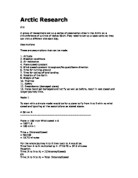Model 1
To start with a simple model would be for the plane to fly from A to B with no wind speed and ignoring all the assumptions as stated above.
A 50 km B
---------------------------------------------------------------------
Plane = 100 mph Wind speed = 0
= 100 x 1.6
= 160 kmh-1
Time = Distance/Speed
= 50/160
= 18.75 minutes
For the whole journey A to B then back to A would be:
Time from A to B multiplied by 2. 2*18.75 = 37.5 minutes
Equation
Time (A to B to A) = 2(Distance/Speed)
Time from A to B multiplied by 2. 2*18.75 = 37.5 minutes
Equation
Time (A to B to A) = 2(Distance/Speed)
OR
Time (A to B to A) = Total Distance/Speed
Model 2
- Base at centre of the 360 degree circle
- Wind speed 25kmh from the west
3. Plane travelling at different speeds but with the same resultant (100kmh)
4. Same altitude
5. Time for landing and taking off (no time applied)
6. Time for turning around (no time applied)
The rest of the assumptions stated above are ignored in this model for simplicity.
Evaluation
When the resultant speed was calculated for right angle triangles Pythagoras´ theorem was used, bearings were found by using Trigonometry (Sin = opposite/hypotenuse Cosine = adjacent/hypotenuse Tangent = opposite/adjacent). For triangles that were not right angled they were drawn to scale.
A way of finding resultant speeds quicker would be to only calculate angles from one quarter of the circle and then use symmetry in the y and x-axis. With angles such as 30 degrees a mirror line could be used in the y = -x axis to find the resultants flying back in the opposite direction. Symmetry in the y-axis would get you the opposites of that angle in which the two triangles are drawn together side by side as shown in my scale drawings for 45-degrees.
The reason for not having time for landing and taking off is because the times would all be the same just with 10-20 minutes or however long it takes for the plane to take off and land added onto the resultant time.
In the scale drawings when finding the opposite resultants at 45 degrees and I had drawn another triangle to the right of the 45 degree triangle (triangle ‘K´), and the opposite of this new triangle I had drawn would be the resulting triangle to the 45 degree triangle. This was another way of working out opposite resulting angles and speeds.
Scale drawings were not drawn for the 90 and 270degrees angle because the speeds could just be added together, there is no triangle because the wind is blowing from the west. The diagram would just be straight line.
On the scale drawings the angles that are coloured in pencil is the angle in which the base is and the other angle is the direction in which the plane has to fly in order to reach the destination.
When flying against the wind at angles that were not perpendicular to the wind the bearing of the plane would have to be set differently to the direction of the base they were flying to. This was so to compensate for the wind blowing them towards their destination. E.g. if base the plane is flying to is at 315-degrees then the nose of the plane would have to be pointed at 307-degrees. This considers the wind speed and the plane speed which when calculated shows that the plane does end up at 315-degrees.
What I have covered in these models are only simplifications of what could be and that they are so simplistic that the only assumptions that are taken into account are. Wind speed and direction and the speed of the plane.
Further work
The cosine curve which has been drawn in Grey is one which is for a 3rd model which is that the resultant speeds were calculated so were the times and then for the journey back to the base there would be no wind. This was done because of the investigation had all sorts of inequalities. This was one which was I had calculated and found that a cosine curve appeared after the results were plotted on to a time, angle graph. The resulting time would be the time it took to get to the other base multiplied by 2. This is still a simple model. The reason for doing this is because the model would have never been thought of because there is supposed to be a strong constant wind. But the wind can stop and if it does how would the models be if there were only models on wind always blowing or wind never blowing. This investigation is in between the two flying to a base with wind then flying home without wind.
More work I could have done was to investigate to see how long journeys would take if the plane had time for taking off and landing or if the plane was to just circle around at the destination and go back to base. The assumption is that it would be easier to model the plane landing and taking off rather than flying around and then back to base because if it was to fly around you would have to model if it was to do a circular or an ellipse turn. The circular turn would be easier to model than the ellipse.






